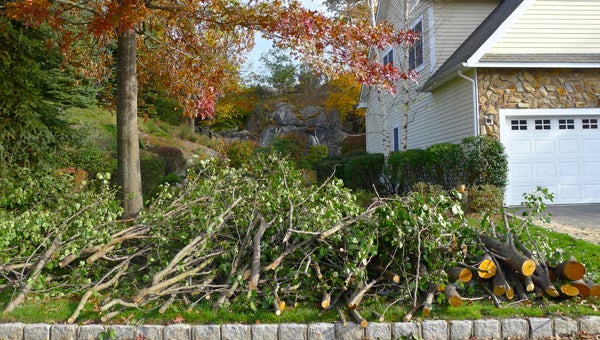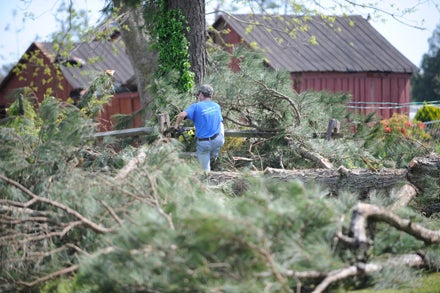Tree work a dangerous deal for the average homeowner
Published 7:48 pm Thursday, July 16, 2015

PROACTIVE VS. REACTIVE: The best way to hurricane-proof trees is to keep them healthy. Thinning out trees also offers less resistance in the face of high winds, keeping trees upright.
Hurricane season started June 1. This year’s season is predicted to be a mild one, with a 70-percent likelihood of only six to 11 named storms, three to six of which will become hurricanes and zero to two of which will become major hurricanes, according to the National Oceanic and Atmospheric Administration.
While many might breathe a sigh of relief about the news, eastern North Carolinians are fully aware that all it takes is one storm to devastate a place (Hurricane Irene, 2011), and that a tropical storm might pack more of a punch than a hurricane, given the right circumstances (Tropical Storm Dennis, 1999).
When a storm blows through, the region’s trees take a hit: saturated ground and strong winds are a recipe for disaster and anything in a tree’s downward path is headed the same way — homes, vehicles and power lines. However, once the wind and waters recede and cleanup commences, homeowners would be wise to call in the professionals rather than tackling felled trees and limbs on their own.

DAILY NEWS
DANGER AWAITS: It would seem like a pretty simple task to separate the trunk from the root system with a chainsaw. However, once severed, the root system can snap back into place, crushing anyone or anything in the way.
“Most homeowners simply don’t have the tools, knowledge or experience necessary to safely attempt their own tree work,” Tchukki Andersen, a staff arborist with the Tree Care Industry Association (TCIA) wrote in a press release. “We hear many unfortunate stories each year of homeowners getting severely injured or killed while attempting this dangerous, and often misunderstood, work on their own.”
It’s not as simple as taking out a chainsaw and getting to work — it’s a matter of physics, knowing how a tree or limb will react when it’s cut, planning proper cuts and how a saw will react while doing the cutting.
“People do not understand the physics of trimming a tree, but they want to do it themselves — not necessarily because they want to save money, but because they want to do something,” said Wayne Woolard, owner of Wayne’s Tree Service.
Woolard has been in the tree business for 41 years, studying the science of trees and their care.
“Most homeowners are hurt or killed using a ladder to trim a tree, because what they cut comes down and hits the ladder — it swings down and hits the ladder and knocks the ladder out from under them and about half the time what they’re cutting falls on them. That’s the most common thing,”

DAILY NEWS
DO NOT TOUCH: Between 1992 and 2007, 1,285 professional tree-care workers were killed on the job. Fourteen percent of them were electrocuted by live power lines. During Hurricane Irene, Brown Street (pictured) had lines felled by limbs.
Rather than risking an accident with a chainsaw — the one tool responsible for more emergency room visits than any other, Woolard suggests being proactive. There’s a way to help trees stay upright when the wind and rain arrive: keeping them healthy.
“Regular maintenance on a tree will help a tree become more hurricane resistant,” Woolard said. “What homeowners need to do is properly maintain their trees by thinning, which is proper pruning, and maintaining the proper soil pH through chemicals and aeration — the aeration part being because of compaction.”
Thinning trees — say, removing two out of five branches in a grouping — actually gives a tree a healthy boost. Woolard has an analogy he uses to describe the process.
“If you have four children and one of them moves out, now you’re not supporting that child — you’ve just increased your income by 25 percent,” Woolard said. “If you take 20 percent of the green branches off a tree, now that tree is not having to supply food for that 20 percent, so it jumpstarts what is left. So that helps the tree recover, because it’s not overstressed.”
In addition to keeping a tree healthy, proper pruning also gives the wind less leverage against a tree and less resistance means it’s more likely to stay upright in high winds. But healthy roots are just as important, Woolard said.
“Proper tree thinning is the way to take care of a tree from the ground up, but the root system is what’s mostly overlooked,” Woolard said.
Woolard said a common mistake that homeowners make is piling dirt and mulch around a tree. While it may look nice, compacting the soil around a tree smothers the root collar. In fact, anything built on top of a tree’s root system will ultimately harm a tree. Driveways are a particularly bad culprit — not only is the soil compacted, leading to decreased aeration, but the vibrations from cars driving over roots can loosen hair roots from their source, impacting the tree’s ability to absorb water. The same goes for any kind of construction equipment driven over a root system, Woolard said.
And a weakened tree is one that will not stand up well to hurricane-force winds.
In the aftermath of a hurricane, services of businesses like Woolard’s are in high demand, but according to Woolard, he’d rather that wasn’t the case.
“I don’t like doing storm work. I’d rather see people do preventative maintenance,” Woolard said.
Calling in the professionals is the way to do it. According to the TCIA press release, there are too many hazards associated with the job to not leave it to the professionals. And even the professionals have their share of accidents. Between 1992 and 2007, 1,285 tree-care workers died in the U.S., according to the Centers for Disease Control and Prevention. Forty-four percent were trimming or pruning a tree when fatally injured, while the most common causes of death were being struck by or against an object (42 percent), most commonly a tree or branch; falls to a lower level (34 percent); and electrocutions (14 percent).
“A climbing tree surgeon is more likely to be maimed or killed than in other occupation,” Woolard said.
Unexpected drops, unseen power lines, chainsaw mishaps — all can create a situation where a do-it-yourselfer is on an unexpected trip to the emergency room. Even something as simple as cutting up a fallen branch for firewood can have its share of hidden hazards, like kick backs from chainsaws hitting ground; the release of tension from a cut causing a limb to roll, and crush.
But if one is convinced that doing it yourself is the way to go, there are a couple of things to remember: never cut above one’s head; do not cut from a ladder; and always have someone with you, just in case of emergency.

DAILY NEWS
DO NOT TOUCH: Between 1992 and 2007, 1,285 professional tree-care workers were killed on the job. Fourteen percent of them were electrocuted by live power lines. During Hurricane Irene, Brown Street (pictured) had lines felled by limbs.





